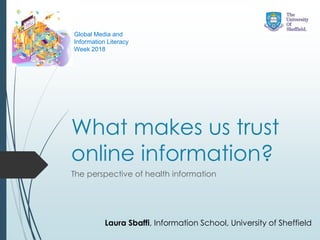
What makes us trust online information? The perspective of health Information
- 1. What makes us trust online information? The perspective of health information Laura Sbaffi, Information School, University of Sheffield Global Media and Information Literacy Week 2018
- 2. What is trust? • Not control but dependency (acceptance of dependence on another) • Uncertainty about the outcome • Trust necessarily faces risk (of failure or damage) Laura Sbaffi, 2018
- 3. Levels of trust Personality characteristic ↓ “I trust” Social tie directed from one person to another ↓ “I trust you” Emergent property of a mutual relationship ↓ “You and I trust each other” Feature of a community as a whole ↓ “We all trust” Adapted from: Kelton, Fleischmann & Wallace, 2008 Laura Sbaffi, 2018
- 4. Overview of online trust Commerce Banking Health Entertainment News Government Social media Education …and many more… Laura Sbaffi, 2018
- 5. Evaluation of online health information What is known about this topic? Laura Sbaffi, 2018
- 6. Source features Site domain (.com) Discussion groups Lack of statement Limited scope Mailing lists Private sponsors/individual owners Site domain (.gov; .edu; .org) Discussion/support groups Age of website Pictures of owners Third party accreditation High ranking in search engine Laura Sbaffi, 2018
- 7. Design features Advertising Complex layout Boring layout No navigation aids Slow No/poor search facilities Obvious commercial look Clear layout Contact details Authority of owner Brand/Logo Interactive features External links Pictures Laura Sbaffi, 2018
- 8. Content features Bias of information Inappropriate Irrelevant Complex Spelling errors Sensationalist Authority of author Credibility Ease of use Content Objectivity Familiarity Currency Laura Sbaffi, 2018
- 9. Does trust formation evolve with age? 1st year students Ease of use Content Recommendation Brand 3rd year students Credibility Usefulness Style Content Ease of use Recommendation Brand General population Content/Credibility Brand Ease of use Recommendation Familiarity Laura Sbaffi, 2018
- 10. …or with gender? Females always score higher values across the three cohorts than males and, sometimes, such differences are statistically significant… 1st year 3rd year General population Brand Brand Credibility Ease of use Familiarity Content Credibility Ease of use Recommendation Usefulness Laura Sbaffi, 2018
- 11. To summarise 1. The evaluation of digital information sources varies across users, hence there is no “one-solution-to-fit-all” 2. People’s trust judgements of online health information become more content-oriented as they progress in age (as opposed to being more user-friendly). 4. The main factors to influence trust judgements across different groups are Content (Credibility), Recommendation, Ease of Use and Brand. 3. Women seem to attribute more importance to specific factors influencing trust formation than men. Laura Sbaffi, 2018
- 12. References • Corritore CL, Kracher B and Wiedenbeck S. On-line trust: concepts, evolving themes, a model. Int. J. Hum.-Comput. Stud. 2003 58(6):737-58. • Hargittai E, Fullerton L, Menchen-Trevino E, Thomas K. Trust online: young adults' evaluation of web content. Int J Commun 2010 4:468-94. • Hilligoss B, Rieh SY. Developing a unifying framework of credibility assessment: Construct, heuristics, and interaction in context. Information Processing & Management. 2008 Jul 1;44(4):1467-84. • Hjørland B. Methods for evaluating information sources: An annotated catalogue. Journal of Information Science. 2012 Jun;38(3):258-68. • Kelton K, Fleischmann KR, Wallace WA. Trust in digital information. Journal of the American Society for Information Science and Technology. 2008 Feb 1;59(3):363-74. • Menchen-Trevino E, Hargittai E. Young adults’ credibility assessment of Wikipedia. Information, Communication & Society. 2011 Feb 1;14(1):24-51. • Metzger MJ, Flanagin AJ. Credibility and trust of information in online environments: the use of cognitive heuristics. J Pragmat 2013 59:210-20. • Nissenbaum H. Securing Trust Online: Wisdom or Oxymoron. Boston University Law Review 2001, 81 (3):635-64. • Rowley J, Johnson F, Sbaffi L. Students’ trust judgements in online health information seeking. Health informatics journal. 2015 Dec;21(4):316-27. • Sbaffi L, Rowley J. Trust and credibility in web-based health information: a review and agenda for future research. Journal of medical Internet research. 2017 Jun;19(6). Laura Sbaffi, 2018
- 13. Thank you Global Media and Information Literacy Week 2018
